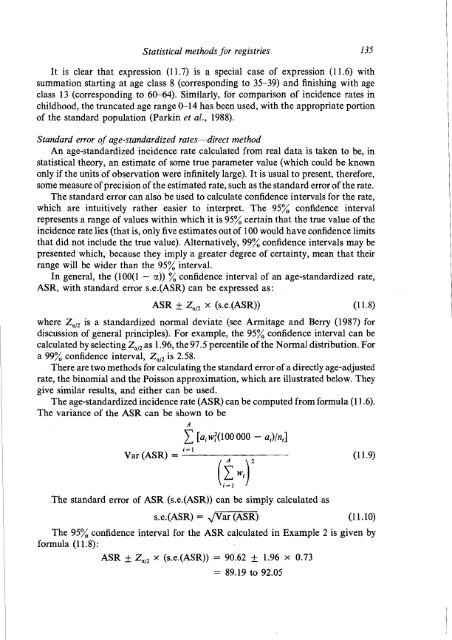Cancer Registration: Principles and Methods - IARC
Cancer Registration: Principles and Methods - IARC
Cancer Registration: Principles and Methods - IARC
Create successful ePaper yourself
Turn your PDF publications into a flip-book with our unique Google optimized e-Paper software.
Statistical methods for registries 135<br />
It is clear that expression (11.7) is a special case of expression (1 1.6) with<br />
summation starting at age class 8 (corresponding to 35-39) <strong>and</strong> finishing with age<br />
class 13 (corresponding to 60-64). Similarly, for comparison of incidence rates in<br />
childhood, the truncated age range 0-14 has been used, with the appropriate portion<br />
of the st<strong>and</strong>ard population (Parkin et al., 1988).<br />
St<strong>and</strong>ard error of age-st<strong>and</strong>ardized rates-direct method<br />
An age-st<strong>and</strong>ardized incidence rate calculated from real data is taken to be, in<br />
statistical theory, an estimate of some true parameter value (which could be known<br />
only if the units of observation were infinitely large). It is usual to present, therefore,<br />
some measure of precision of the estimated rate, such as the st<strong>and</strong>ard error of the rate.<br />
The st<strong>and</strong>ard error can also be used to calculate confidence intervals for the rate,<br />
which are intuitively rather easier to interpret. The 95% confidence interval<br />
represents a range of values within which it is 95% certain that the true value of the<br />
incidence rate lies (that is, only five estimates out of 100 would have confidence limits<br />
that did not include the true value). Alternatively, 99% confidence intervals may be<br />
presented which, because they imply a greater degree of certainty, mean that their<br />
range will be wider than the 95% interval.<br />
In general, the (100(1 - a)) % confidence interval of an age-st<strong>and</strong>ardized rate,<br />
ASR, with st<strong>and</strong>ard error s.e.(ASR) can be expressed as:<br />
ASR f Za12 x (s.e.(ASR)) (11.8)<br />
where ZaI2 is a st<strong>and</strong>ardized normal deviate (see Armitage <strong>and</strong> Berry (1987) for<br />
discussion of general principles). For example, the 95% confidence interval can be<br />
calculated by selecting ZaI, as 1.96, the 97.5 percentile of the Normal distribution. For<br />
a 99% confidence interval, Za12 is 2.58.<br />
There are two methods for calculating the st<strong>and</strong>ard error of a directly age-adjusted<br />
rate, the binomial <strong>and</strong> the Poisson approximation, which are illustrated below. They<br />
give similar results, <strong>and</strong> either can be used.<br />
The age-st<strong>and</strong>ardized incidence rate (ASR) can be computed from formula (1 I .6).<br />
The variance of the ASR can be shown to be<br />
Var (ASK) =<br />
A<br />
1<br />
[ai 4(1OO 000 - ai)/ni]<br />
/A l2<br />
The st<strong>and</strong>ard error of ASR (s.e.(ASR)) can be simply calculated as<br />
The 95% confidence interval for the ASR calculated in Example 2 is given by<br />
formula (11.8):<br />
ASR + Za12 x (s.e.(ASR)) = 90.62 f 1.96 x 0.73
















